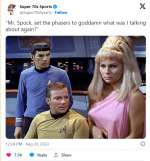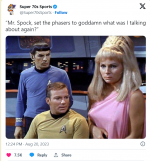BigFootsCousin
Molon Labe!
MSN
www.msn.com
Fair Use-
Story by Donna Sarkar • 7h
At one time, traveling to space seemed impossible. But now, hundreds of people have left Earth's atmosphere and drifted in outer space. While there is still much to explore, thanks to researchers and astronauts, some cosmic mysteries have been uncovered.
For example, we know that one of the many differences between Earth and outer space is the amount of gravity. According to NASA, there is only a small amount of gravity in space, unlike Earth, where the force consistently pulls us downward and allows our feet to stay planted on the ground. However, the low gravity in space makes both people and objects more prone to floating.
The more we've come to learn about gravity in space, the more we know about which objects don't belong in space. Thanks to the low gravity in outer space, these items have been scratched from the eligibility list for space travel, and some may surprise you.
1. Are Chairs Allowed in Space?
Furniture in space is a bit different than it is here on Earth. Common items like chairs serve no purpose when little gravity is present. With minimal gravity, it's difficult to sit in a chair, let alone have a chair stay stationary without it bolted to the floor.
In fact, the International Space Station, a large spacecraft that serves as a home and science laboratory where astronauts reside, has nowhere to sit down on the ground. Since traditional furniture like chairs would essentially just float in space, they're considered more of a hazard than a convenience.
Where Do Astronauts Sit When They Eat Meals?
While traditional chairs may not be found aboard the International Space Station, astronauts must still eat at least three meals a day. So where do they sit while eating these meals?It turns out that astronauts just try to steady themselves while floating when eating their meals. It does help that their meals have specific restrictions and are pre-packaged or canned, allowing for minimal mess. There are also food trays present that connect to a wall or to the astronaut's lap through fabric fasteners that are designed to keep their food in place.
2. Are Pens and Pencils Allowed in Space?
In the 1960s, during the rise of space exploration, NASA scientists quickly discovered that it was nearly impossible to utilize ink or ballpoint pens in space. Astronauts would have a difficult time using pens due to the lack of gravity, which prevented the ink from the cartridge from making its way down to the tip and transferring it onto paper.
Pencils, on the other hand, were also forbidden as broken graphite could cause a hazard to the crew, or float and get stuck in crucial electronics. Not to mention, the flammable wood from the pencil posed a danger in and of itself.
What Do Astronauts Use to Write in Space?
Surely, astronauts have a lot to report on while they're in space. This is exactly why a special space pen called the Fisher Space Pen, an anti-gravity pen created by Paul Fisher and launched into space on every NASA spacecraft with crew aboard since 1968. The pen utilizes a nitrogen-pressurized ink cartridge that allows for use even amidst zero gravity.3. Can You Eat Bread in Space?
Crumbs and space are not the greatest mixtures. While bread can be considered a diet staple and a great source of carbohydrates, its crumbly and messy nature makes it unsuitable on the space station. Cleanliness is of the utmost importance, and crumbs can easily fly with little gravity. This, combined with bread's short shelf life, makes it another item that's not allowed in space.
What Do Astronauts Eat in Space Instead?
Don't worry, astronauts can still have peanut butter and jelly sandwiches. They'll just have to use tortillas instead of bread. Another option is to use pita or flatbread, essentially anything that minimizes crumbs.4. Can You Drink Carbonated Drinks in Space?
If you can't go without soda, then space is probably not for you. In fact, all carbonated drinks are not allowed in space because their properties change, causing trouble for astronauts.
Due to microgravity, the dissolved carbon dioxide in these drinks doesn't separate and rise to the top like it does on Earth. If consumed in minimal gravity, the carbonation throughout the drink can cause discomfort for astronauts and produce symptoms similar to acid reflux. Plus, with microgravity, these drinks would also likely float around in space and cause a bigger mess, not to mention the additional pollution that beverage cans would add to the spacecraft.
What Do Astronauts Drink in Space?
The best option for astronauts to prevent dehydration is water. Whole milk and alcohol are unsuitable for space as they don't dissolve properly and contain ingredients that can damage equipment. Freeze-dried drink mixes are other options though, since they can be added to water.5. Are Salt and Pepper Allowed in Space?
In space with microgravity, seasonings are a hazard because they can make quite a mess, which is why they've been banned from space travel. Seasonings can easily crumble into bits and pieces that can clog air purifiers and filters and potentially even damage equipment.
This means that popular seasonings like salt and pepper aren't available in their traditional form. However, small individual packets of liquid salt and pepper can be utilized by astronauts in space.
6. Can Astronauts Eat Ice Cream in Space?
Unfortunately, one of the most popular desserts on Earth is not allowed in space in its traditional form. The messy nature of ice cream makes it somewhat impractical to enjoy while floating in space. Moreover, ice cream has a certain shelf life of about six weeks to stay fresh in the freezer once opened, a requirement that the strict conditions aboard the spacecraft can't cater to.



